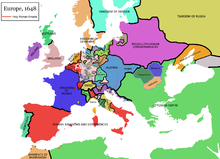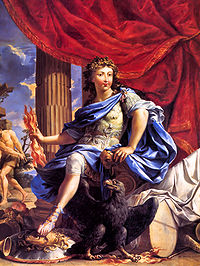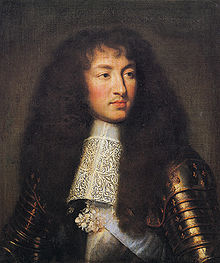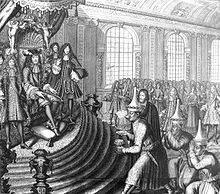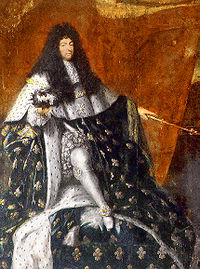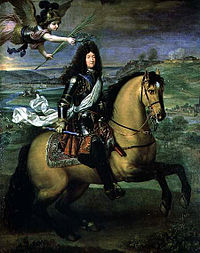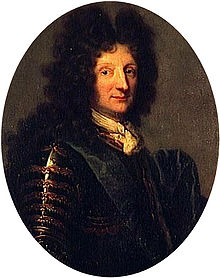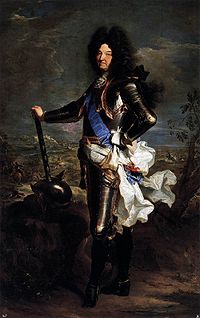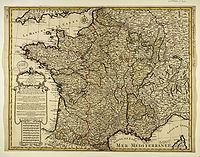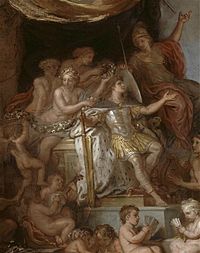- Louis XIV of France
-
"Louis XIV" and "Louis Quatorze" redirect here. For other uses, see Louis XIV (disambiguation) and Louis Quatorze (disambiguation)."Sun King" and "Le Roi Soleil" redirect here. For the Beatles song, see Sun King (song). For the French musical, see Le Roi Soleil (musical).
Louis XIV 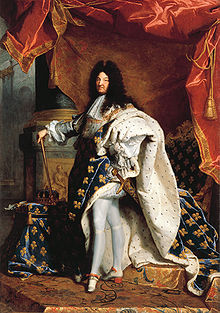
Louis XIV (1638–1715), by Hyacinthe Rigaud (1701) King of France and Navarre Reign 14 May 1643 – 1 September 1715
(72 years, 110 days)Coronation 7 June 1654 (aged 15) Predecessor Louis XIII Successor Louis XV Regent Anne of Austria (until 1651) Spouse Maria Theresa of Spain
Françoise d'AubignéIssue Louis, le Grand Dauphin
Princess Anne Élisabeth
Princess Marie Anne
Princess Marie Thérèse
Philippe Charles, Duke of Anjou
Louis François, Duke of AnjouFull name Louis-Dieudonné de France House House of Bourbon Father Louis XIII of France Mother Anne of Austria Born 5 September 1638
Château de Saint-Germain-en-Laye, Saint-Germain-en-Laye, FranceDied 1 September 1715 (aged 76)
Palace of Versailles, Versailles, FranceBurial Saint Denis Basilica, Saint-Denis, France Signature 
Religion Catholicism Louis XIV (5 September 1638 – 1 September 1715), known as Louis the Great (French: "Louis le Grand") or the Sun King (French: le Roi-Soleil), was King of France and of Navarre.[1] His reign, from 1643 to his death in 1715, began at the age of four and lasted seventy-two years, three months, and eighteen days. As such, it is one of the longest documented reigns of any European monarch.[2]
Louis began his personal rule of France in 1661 after the death of his chief minister, the Italian Cardinal Mazarin.[3] An adherent of the theory of the divine right of kings, which advocates the divine origin and lack of temporal restraint of monarchical rule, Louis continued his predecessors' work of creating a centralized state governed from the capital. He sought to eliminate the remnants of feudalism persisting in parts of France and, by compelling the noble elite to inhabit his lavish Palace of Versailles, succeeded in pacifying the aristocracy, many members of which had participated in the Fronde rebellion during Louis' minority. By these means he consolidated a system of absolute monarchical rule in France that endured until the French Revolution.
France was the leading European power and fought three major wars: the Franco-Dutch War, the War of the League of Augsburg, and the War of the Spanish Succession—and two minor conflicts—the War of Devolution and the War of the Reunions. Louis encouraged and benefited from the work of prominent political, military and cultural figures such as Mazarin, Colbert, Turenne and Vauban, as well as Molière, Racine, Boileau, La Fontaine, Lully, Le Brun, Rigaud, Le Vau, Mansart, Charles and Claude Perrault, and Le Nôtre.
Upon his death just days before his seventy-seventh birthday, Louis was succeeded by his five-year-old great-grandson, Louis XV. All his intermediate heirs—his son Louis, le Grand Dauphin; the Dauphin's eldest son Louis, duc de Bourgogne; and Bourgogne's eldest son and his second eldest son, Louis, duc de Bretagne (the older brothers of the future Louis XV)—predeceased him.
Birth and ancestry
Louis XIV was born on 5 September 1638 in the Chateau of Saint-Germain-en-Laye to Louis XIII and Anne of Austria. At the time of his birth, his parents had been married for twenty-three years without surviving issue (his mother experienced four stillbirths between 1619 and 1631). Leading contemporaries thus regarded him as a divine gift, and his birth, a miracle of God. He was often referred to as "Louis-Dieudonné" (Louis-God-given)[4] and also bore the traditional title of French heirs apparent—Dauphin.[5]
Recognising that his death was imminent, Louis XIII in 1643 prepared for his son's impending minority rule. He decreed that a regency council should rule on Louis's behalf for the duration of the minority. Contrary to custom, he did not make Anne the sole regent despite her having given birth to Louis and his brother Philippe, because he doubted her political abilities. He did however make her the head of the Council.
Minority and the Fronde
On 14 May 1643, with Louis XIII dead, Anne had her husband's will annulled by the Parlement de Paris (a judicial body comprising mostly nobles and high clergymen), abolished the regency council, and became the sole regent. She then entrusted power to Cardinal Mazarin.
Subsequently, in 1648, Mazarin successfully negotiated the Peace of Westphalia. Although war continued between France and Spain until the Treaty of the Pyrenees in 1659, the Peace of Westphalia ended the Thirty Years' War in Germany. Its terms ensured Dutch independence from Spain, awarded some autonomy to the various German princes, and granted Sweden seats on the Imperial Diet and territories to control the mouths of the Oder, Elbe and Weser. France, however, profited most from the settlement. Austria ceded to France all Habsburg lands and claims in Alsace and acknowledged her de facto sovereignty over the Three Bishoprics. Moreover, eager to emancipate themselves from Habsburg domination, petty German states sought French protection. This anticipated the formation of the 1658 League of the Rhine, leading to the further diminution of Imperial power.
As the Thirty Years' War came to an end, a civil war—the Fronde—erupted in France. It effectively checked France's ability to exploit the Peace of Westphalia. Mazarin had largely pursued the policies of his predecessor, Cardinal Richelieu, augmenting the Crown's power at the expense of the nobility and the Parlements. The Frondeurs, political heirs of a dissatisfied feudal aristocracy, sought to protect their traditional feudal privileges from an increasingly centralized royal government. Furthermore, they believed their traditional influence and authority was being usurped by the recently ennobled bureaucrats (the Noblesse de Robe) who administered the Kingdom and on whom the Monarchy increasingly began to rely. This belief intensified their resentment.
In 1648, Mazarin attempted to tax members of the Parlement de Paris. The members not only refused to comply, but also ordered all his earlier financial edicts burned. Buoyed by the victory of Louis, duc d’Enghien (later le Grand Condé) at Lens, Mazarin arrested certain members in a show of force. Paris erupted in rioting. A mob of angry Parisians broke into the royal palace and demanded to see their king. Led into the royal bedchamber, they gazed upon Louis, who was feigning sleep, were appeased, and quietly departed. The threat to the royal family prompted Anne to flee Paris with the king and his courtiers. Shortly thereafter, the conclusion of the Peace of Westphalia allowed Condé's army to return to aid Louis and his court.
As this first Fronde (Fronde parlementaire, 1648–1649) ended, a second (Fronde des princes, 1650–1653) began. Unlike that which preceded it, tales of sordid intrigue and half-hearted warfare characterised this second phase of upper-class insurrection. To the aristocracy, this rebellion represented a protest against and a reversal of their political demotion from vassals to courtiers. It was headed by the highest-ranking French nobles, among them Louis's uncle, Gaston, duc d'Orléans, and first cousin, la Grande Mademoiselle; more distantly related Princes of the Blood, like Condé, his brother, Conti, and their sister the duchesse de Longueville; dukes of legitimised royal descent, such as Henri, duc de Longueville, and François, duc de Beaufort; and princes étrangers, such as Frédéric Maurice, duc de Bouillon, his brother, the famous Marshal of France, Turenne, and Marie de Rohan, duchesse de Chevreuse; and scions of France's oldest families, such as François, duc de La Rochefoucauld.
The Frondeurs claimed to act on Louis's behalf and in his real interest against his mother and Mazarin. However, Louis's coming-of-age and subsequent coronation deprived them of their pretext for revolt. Thus, the Fronde gradually lost steam and ended in 1653, when Mazarin returned triumphantly after having fled into exile on several occasions.
Personal reign and reforms
On Mazarin's death in 1661, Louis assumed personal control of the reins of government. He was able to utilize the widespread public yearning for law and order resulting from prolonged foreign war and domestic civil strife to further consolidate central political authority and reform at the expense of the feudal aristocracy. Praising his ability to choose and encourage men of talent, Chateaubriand noted that "it is the voice of genius of all kinds which sounds from the tomb of Louis".[6]
Louis began his personal reign with administrative and fiscal reforms. In 1661, the treasury verged on bankruptcy. To rectify the situation, Louis chose Jean-Baptiste Colbert as Contrôleur général des Finances in 1665. However, Louis first had to eliminate Nicolas Fouquet, the Surintendant des Finances. Fouquet was charged with Embezzlement. The Parlement found him guilty and sentenced him to exile. However, Louis commuted the sentence to life-imprisonment and also abolished Fouquet's post. Although Fouquet's financial indiscretions were not really very different from Mazarin before or Colbert after him, his ambition was worrying to Louis. He had, for example, built an opulent château at Vaux-le-Vicomte where he lavishly entertained a comparatively poorer Louis. He appeared eager to succeed Mazarin and Richelieu in assuming power and indiscreetly purchased and privately fortified Belle Île. These acts sealed his doom.
Divested of Fouquet, Colbert reduced the national debt through more efficient taxation. The principal taxes included the aides and douanes (both customs duties), the gabelle (a tax on salt), and the taille (a tax on land). Louis and Colbert also had wide-ranging plans to bolster French commerce and trade. Colbert's mercantilist administration established new industries and encouraged manufacturers and inventors, such as the Lyon silk manufacturers and the Manufacture des Gobelins, a producer of tapestries. He invited manufacturers and artisans from all over Europe to France, such as Murano glassmakers, Swedish ironworkers, and Dutch shipbuilders. In this way, he aimed to decrease foreign imports while increasing French exports, hence reducing the net outflow of precious metals from France.
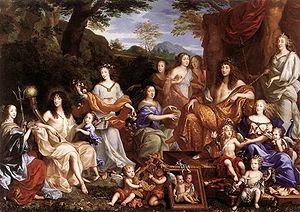 Louis and his family portrayed as Roman gods in a 1670 painting by Jean Nocret. L to R: Louis's aunt, Henriette-Marie; his brother, Philippe, duc d'Orléans; the Duke's daughter, Marie Louise d'Orléans, and wife, Henriette-Anne Stuart; the Queen-mother, Anne of Austria; three daughters of Gaston d'Orléans; Louis XIV; the Dauphin Louis; Queen Marie-Thérèse; la Grande Mademoiselle.
Louis and his family portrayed as Roman gods in a 1670 painting by Jean Nocret. L to R: Louis's aunt, Henriette-Marie; his brother, Philippe, duc d'Orléans; the Duke's daughter, Marie Louise d'Orléans, and wife, Henriette-Anne Stuart; the Queen-mother, Anne of Austria; three daughters of Gaston d'Orléans; Louis XIV; the Dauphin Louis; Queen Marie-Thérèse; la Grande Mademoiselle.
Louis instituted reforms in military administration through Le Tellier and his son Louvois. They helped to curb the independent spirit of the nobility, imposing order on them at court and in the army. Gone were the days when generals protracted war at the frontiers while bickering over precedence and ignoring orders from the capital and the larger politico-diplomatic picture. The old military aristocracy (the Noblesse d'épée) ceased to have a monopoly over senior military positions and rank. Louvois in particular pledged himself to modernizing the army, re-organizing it into a professional, disciplined and well-trained force. He was devoted to the soldiers' material well-being and morale, and even tried to direct campaigns.
Legal matters did not escape Louis's attention, as is reflected in the numerous Grandes Ordonnances he enacted. Pre-revolutionary France was a patchwork of legal systems, with as many coutumes as there were provinces, and two co-existing legal traditions—customary law in the northern pays de droit coutumier and Roman civil law in the southern pays de droit écrit.[7] The 'Grande Ordonnance de Procédure Civile' of 1667, also known as Code Louis, was a comprehensive legal code attempting a uniform regulation of civil procedure throughout legally irregular France. It prescribed inter alia baptismal, marriage and death records in the state's registers, not the church's, and also strictly regulated the right of the Parlements to remonstrate.[8] The Code Louis played an important part in French legal history as the basis for the Code Napoléon, itself the origin of many modern legal codes.
One of Louis's more infamous decrees was the Grande Ordonnance sur les Colonies of 1685, also known as Code Noir. Although it sanctioned slavery, it did attempt to humanise the practice by prohibiting the separation of families. Additionally, in the colonies, only Roman Catholics could own slaves, and these had to be baptised.
Patronage of the arts
The Sun King generously supported the royal court and those who worked under him. He brought the Académie Française under his patronage, and became its "Protector". He allowed Classical French literature to flourish by protecting such writers as Molière, Racine and La Fontaine, whose works remain greatly influential to this day. Louis also patronised the visual arts by funding and commissioning various artists, such as Charles Le Brun, Pierre Mignard, Antoine Coysevox and Hyacinthe Rigaud whose works became famous throughout Europe. In music, composers and musicians such as Lully, Chambonnières and François Couperin thrived.
Over the course of four building campaigns, Louis converted a hunting lodge built by Louis XIII into the spectacular Palace of Versailles. With the exception of the current Royal Chapel (built near the end of Louis's reign), the palace achieved much of its current appearance after the third building campaign, which was followed by an official move of the royal court to Versailles on 6 May 1682.
Versailles became a dazzling, awe-inspiring setting for state affairs and the reception of foreign dignitaries. At Versailles, the king alone commanded attention. Several reasons have been suggested for the creation of the extravagant and stately palace, as well as the relocation of the monarchy's seat. For example, Saint-Simon speculated that Louis viewed Versailles as an isolated power center where treasonous cabals could be more readily discovered and foiled.[9] Alternatively, the Fronde allegedly caused Louis to hate Paris, which he abandoned for a country retreat. However, his many improvements, embellishments and developments of Paris, such as the establishment of a police and street-lighting,[10] lend little credence to this theory. As further examples of his continued care for the capital, Louis constructed the Hôtel des Invalides—a military complex and home to this day for officers and soldiers rendered infirm either by injury or age. While pharmacology was still quite rudimentary in his day, les Invalides pioneered new treatments and set new standards for hospice treatment. The conclusion of the Treaty of Aix-la-Chapelle in 1668 also induced Louis to demolish the northern walls of Paris in 1670 and replace them with wide tree-lined boulevards.[11]
Louis also renovated and improved the Louvre and many other royal residences. Bernini was originally to plan additions to the Louvre. However, his plans would have meant the destruction of much of the existing structure, replacing it with an Italian summer villa in the centre of Paris. Bernini's plans were eventually shelved in favour of Perrault's elegant colonnade. With the relocation of the court to Versailles, the Louvre was given over to the arts and the public.[12] During his visit from Rome, Bernini also executed a portrait bust of the king.
Royal styles of
King Louis XIV
Par la grâce de Dieu, Roi de France et de Navarre
Reference style His Most Christian Majesty Spoken style Your Most Christian Majesty Alternative style Monsieur Le Roi Early wars in the Low Countries
The death of Philip IV of Spain in 1665 precipitated the War of Devolution. In 1660, Louis had married Philip IV's eldest daughter, Maria Theresa, as part of the 1659 Treaty of the Pyrenees. The marriage treaty specified that Maria Theresa was to renounce all claims to Spanish territory for herself and all her descendants. However, Mazarin and Lionne made the renunciation conditional on the full payment of a Spanish dowry of 500,000 écus.[13] The dowry was never paid and would later play a part persuading Charles II of Spain to leave his empire to Philippe d'Anjou (later Philip V of Spain)—the grandson of Louis and Maria Theresa.
The War of Devolution did not focus on the payment of the dowry. Rather, Louis's pretext for war was the "devolution" of land. In Brabant, children of the first marriage traditionally were not disadvantaged by their parents’ remarriages, and still inherited property. Louis's wife was Philip IV's daughter by his first marriage, while the new King of Spain, Charles II, was his son by a subsequent marriage. Thus, Brabant allegedly "devolved" on Maria Theresa. This excuse led to France's attack on the Spanish Netherlands.
Internal problems in the Dutch Republic aided Louis's designs. The most prominent politician in the United Provinces at the time, Johan de Witt, Grand Pensionary, feared the ambition of the young William III, Prince of Orange, specifically dispossession of his supreme power and the restoration of the House of Orange to the influence it had enjoyed before the death of William II, Prince of Orange. The Dutch were thus initially more preoccupied with domestic affairs than the French advance into Spanish territory. Moreover, the French were nominally their allies against the English in the ongoing Second Anglo-Dutch War. Shocked by the rapidity of French successes and fearful of the future, the Dutch nonetheless turned on their nominal allies and made peace with England. Joined by Sweden, the English and Dutch formed a Triple Alliance in 1668. The threat of an escalation of the conflict and a secret treaty partitioning the Spanish succession with Holy Roman Emperor Leopold I, the other major claimant to the throne of Spain, induced Louis to make peace.
The Triple Alliance did not last very long. In 1670, French gold bought the adherence of Charles II of England to the secret Treaty of Dover. France and England, along with certain Rhineland princes, declared war on the United Provinces in 1672, sparking off the Franco-Dutch War. The rapid invasion and occupation of most of the Netherlands precipitated a coup that toppled De Witt and brought William III to power.
In 1674, when France lost the assistance of England, which sued for peace by the Treaty of Westminster, William III received the help of Spain, the Emperor Leopold I, and the rest of the Empire. Despite these diplomatic reverses, the French continued to triumph against overwhelming opposing forces. Within a few weeks, French forces led by Louis captured all of Spanish-held Franche-Comté in 1674. Despite being greatly outnumbered, Condé trounced William III's coalition army of Austrians, Spaniards and Dutchmen at the Battle of Seneffe, and prevented him from descending on Paris. Another outnumbered general, Turenne, conducted a daring and brilliant campaign in the winter of 1674–1675 against the Imperial armies under Raimondo Montecuccoli, driving them back across the Rhine out of Alsace, which had been invaded. Through a series of feints, marches and counter-marches in 1678, Louis besieged and captured Ghent. By placing Louis in a military position far superior to his enemies, these victories brought the war to a speedy end. Six years of war had exhausted Europe, and peace negotiations were soon concluded in 1678 with the Treaty of Nijmegen. Although Louis returned all Dutch territory he captured, he retained Franche-Comté and gained more land in the Spanish Netherlands.
The conclusion of a general peace permitted Louis to intervene in the Scanian War in 1679 on behalf of his ally Sweden. He forced Brandenburg-Prussia to the peace table at the Treaty of Saint-Germain-en-Laye and imposed peace on Denmark-Norway by the Treaty of Fontainebleau and the Peace of Lund.
The successful conclusion of the Treaty of Nijmegen enhanced French influence in Europe, but Louis was still not satisfied. In 1679, he dismissed his foreign minister Simon Arnauld, marquis de Pomponne, because he was seen as having compromised too much with the allies. Louis maintained the strength of his army, but in his next series of territorial claims, Louis avoided using military force alone. Rather, he combined it with legal pretexts in his efforts to augment the boundaries of his kingdom. Contemporary treaties were intentionally phrased ambiguously. Louis established the Chambres des Réunions to determine the full extent of his rights and obligations under those treaties.
Cities and territories such as Luxembourg and Casale were prized for their strategic position on the frontier and access to important waterways. Louis also sought Strasbourg, an important strategic crossing on the Rhine through which various Imperial armies had invaded France. Although a part of Alsace, Strasbourg was not part of Habsburg-ruled Alsace and was thus not ceded to France in the Peace of Westphalia. Following the determinations of the Chambres des Réunions, Louis seized these and other territories. Infuriated by his annexations, Spain declared war, precipitating the War of the Reunions. However, the Spanish were rapidly defeated because the Emperor (distracted by the Great Turkish War) abandoned them, and the Dutch only supported them minimally. By the Truce of Ratisbon in 1684, Spain was forced to cede most of the conquered territories to France for a duration of 20 years.[14]
Non-European relations and the colonies
French colonies multiplied in the Americas, Asia and Africa during Louis's reign, and French explorers made important discoveries in North America. Jolliet and Marquette discovered the Mississippi River in 1673. In 1682, Cavelier de La Salle followed the Mississippi to the Gulf of Mexico and claimed the vast Mississippi basin in Louis's name, calling it Louisiane. French trading posts were also established in India at Chandernagore and Pondicherry, and in the Indian Ocean at Île Bourbon.
Meanwhile, diplomatic relations were initiated with distant countries. In 1669, Suleiman Aga led an Ottoman embassy, reviving the old Franco-Ottoman alliance.[15] Then, in 1682, after the reception of the embassy of Mohammed Tenim in France, Moulay Ismail, Sultan of Morocco, allowed French consular and commercial establishments in his country.[16] Louis once again received a Moroccan ambassador in 1699. He also received a Persian embassy led by Mohammed Reza Beg in 1715.
From further afield, Siam dispatched an embassy in 1684, reciprocated by the French magnificently the next year under Alexandre, Chevalier de Chaumont. This, in turn, was succeeded by another Siamese embassy under Kosa Pan superbly received at Versailles in 1686. Louis then sent another embassy in 1687 under Simon de la Loubère, and French influence grew at the Siamese court, which granted Mergui as a naval base to France. However, the death of Narai, King of Ayutthaya, the execution of his pro-French minister Phaulkon and the Siege of Bangkok in 1688 ended this era of French influence.[17]
France also actively participated in Jesuit missions to China. To break the Portuguese dominance there, Louis sent five Jesuit "mathematicians" (Fontaney, Bouvet, Gerbillon, Le Comte and Visdelou) to the court of the Kangxi Emperor in 1685.[18] Louis also received the visit of a Chinese Jesuit, Michael Shen Fu-Tsung.[19] Furthermore, he had at his court a Chinese librarian and translator—Arcadio Huang.[20][21]
Height of power
By the early 1680s Louis had greatly augmented French influence in the world. Domestically, he successfully increased the Crown's influence and authority over the Church and aristocracy, thus consolidating absolute monarchy in France.
Louis initially supported traditional Gallicanism, which limited papal authority in France, and convened an Assemblée du Clergé in November 1681. Before its dissolution eight months later, the Assembly had accepted the Declaration of the Clergy of France, which increased royal authority at the expense of papal power. Without royal approval, bishops could not leave France and appeals could not be made to the Pope. Additionally, government officials could not be excommunicated for acts committed in pursuance of their duties. Although the King could make ecclesiastical law, all papal regulations without royal assent were invalid in France. Unsurprisingly, the pope repudiated the Declaration.[3]
 Louis receiving the Doge of Genoa at Versailles on 15 May 1685, following the Bombardment of Genoa. (Reparation faite à Louis XIV par le Doge de Gênes. 15 mai 1685 by Claude Guy Halle, Versailles.)
Louis receiving the Doge of Genoa at Versailles on 15 May 1685, following the Bombardment of Genoa. (Reparation faite à Louis XIV par le Doge de Gênes. 15 mai 1685 by Claude Guy Halle, Versailles.)
By attaching nobles to his court, Louis achieved increased control over the French aristocracy. Pensions and privileges necessary to live in a style appropriate to their rank were only possible by waiting constantly on Louis.[9] Moreover, by entertaining, impressing and domesticating them with extravagant luxury and other distractions, Louis expected them to remain under his scrutiny. This prevented them from passing time on their own estates and in their regional power-bases, from which they historically waged local wars and plotted resistance to royal authority.[22] Louis thus compelled and seduced the old military aristocracy (the noblesse d'épée) into becoming his ceremonial courtiers, further weakening their power. The underlying rationale for Louis's actions could be found in experiences of the Fronde. Louis judged that royal power thrived better by filling high executive or administrative posts with commoners or the more recently ennobled bureaucratic aristocracy (the noblesse de robe). These could be more easily dismissed than a grandee of ancient lineage whose entrenched influence would be more difficult to destroy. In fact, Louis's final victory over the nobility may have ensured the end of major French civil wars until the Revolution about a century later.
The 1680s would see France not only becoming more isolated from its former allies,[23] but also at the height and apogee of its power. Louis's policy of Réunions brought France to its largest extent during his reign. Furthermore, the bombardment of the Barbary pirate strongholds of Algiers and Tripoli produced favourable treaties and the liberation of Christian slaves. Lastly, in 1684, Louis ordered the bombardment of Genoa for its support of Spain in previous wars, and procured Genoese submission and an official apology by the Doge at Versailles.
Personal life
Having been married in 1660, Louis and Maria Theresa of Spain had six children. However, only one child, the eldest, survived to adulthood: Louis, le Grand Dauphin, known as Monseigneur. Maria Theresa died in 1683, whereupon Louis remarked that she had caused him unease on no other occasion.
Despite evidence of affection early on in their marriage, Louis did not remain faithful to Maria Theresa for long. He took a series of mistresses, both official and unofficial, among them Mademoiselle de La Vallière, Madame de Montespan, and Mademoiselle de Fontanges. Through these liaisons, he produced numerous illegitimate children, most of whom he married to members of cadet branches of the royal family.
Louis proved more faithful to his second wife, Madame de Maintenon. It is believed that they were married secretly on or around 10 October 1683 at Versailles.[24] This marriage, though never announced or publicly discussed, was an open secret and lasted until his death.[25]
Revocation of the Edict of Nantes
It has traditionally been suggested that Madame de Maintenon pushed Louis to persecute Protestants and revoke the Edict of Nantes, which had awarded Huguenots political and religious freedom, but this is now being questioned.[26] Louis himself saw the persistence of Protestantism as a disgraceful reminder of royal powerlessness. After all, the Edict was Henry IV's pragmatic concession to end the longstanding Wars of Religion. Moreover, since the 1555 Peace of Augsburg, the prevailing contemporary European principle to assure socio-political stability was cuius regio, eius religio— the religion of the ruler should be the religion of the realm.[27]
Responding to petitions, Louis initially excluded Protestants from office, constrained the meeting of synods, closed churches outside Edict-stipulated areas, banned Protestant outdoor preachers, and prohibited domestic Protestant migration. He also disallowed Protestant-Catholic intermarriages if objections existed, encouraged missions to the Protestants and rewarded converts to Catholicism.[28] Despite this discrimination, Protestants largely did not rebel, and there occurred a steady conversion of Protestants, especially among the noble elites.
In 1681, Louis dramatically increased his persecution of Protestants. The principle of cuius regio, euis religio generally had also meant that subjects who refused to convert could emigrate, but Louis banned emigration and effectively insisted that all Protestants must be converted. Secondly, following René de Marillac and Louvois's proposal, he began quartering dragoons in Protestant homes. Although this was within his legal rights, the dragonnades inflicted severe financial strain on Protestants and atrocious abuse. Between 300,000 and 400,000 Huguenots nominally converted, as this entailed financial rewards and exemption from the dragonnades.[29]
On 15 October 1685, citing the extensive conversion of Protestants which rendered privileges for the remainder redundant, Louis issued the Edict of Fontainebleau, which revoked the Edict of Nantes.[3] His reasons for doing so have been debated. Louis may have been seeking to placate the Catholic Church, which had chafed under his numerous restrictions, or he may have acted to regain international prestige after the defeat of the Turks without French aid, or to end the remaining division in French society dating to the Wars of Religion.[30] Perhaps, he may have just been motivated by his coronation oath to eradicate heresy.[31]
The Edict of Fontainebleau exiled pastors, demolished churches, instituted forced baptisms and banned Protestant groups.[32] Defying royal decree, about 200,000 Huguenots (roughly one-fourth of the Protestant population, or 1% of the French population) fled France, taking their skills with them. Thus, some have found the Edict very injurious to France.[33] However, others believe this an exaggeration. Although many left, most of France's preeminent Protestant businessmen and industrialists converted and remained.[34] The reaction to the Revocation was mixed. French Catholic leaders applauded, but Protestants across Europe were horrified, and even Pope Innocent XI, still arguing with Louis over Gallicanism, criticised the violence.
The League of Augsburg
Main article: War of the Grand AllianceCauses and conduct of the war
The War of the League of Augsburg (1688–1697) had two immediate causes with French influence in the Rhineland at stake. First, the death of Charles II, Elector Palatine in 1685 caused a succession crisis, in which Louis's sister-in-law Elizabeth Charlotte of the Palatinate had interests.[35] The death of Max Henry, Archbishop of Cologne produced another succession crisis in 1688.[36]
Growing concern about France led to the formation of the 1686 League of Augsburg by the Emperor, Spain, Sweden, Saxony and Bavaria; it intended to return France at least to the borders agreed to in the Treaty of Nijmegen.[37] Conversely, the Emperor's refusal to change Ratisbon into a permanent treaty amplified Louis's fear that the Emperor's Balkan victories entailed an imminent attack on the Reunions.[38]
The birth of James II's son and Catholic heir, James Stuart, precipitated the Glorious Revolution, an event that Louis found threatening. The Protestant William III of Orange, grandson of Charles I, sailed for England with troops despite Louis's warning that France would regard it as a casus belli. James II was deposed and his throne expropriated by his daughter Mary II and his son-in-law and nephew William III (now also of England). Vehemently anti-French, William III pushed his new kingdoms into war, thus transforming the League of Augsburg into the Grand Alliance. In 1688, however, this was as yet unsettled. Expecting the expedition to absorb William III and his allies, Louis dispatched troops to the Rhineland to compel confirmation of Ratisbon and acceptance of his demands about the succession crises, as his ultimatum to the German princes indicated. He also sought to protect his eastern provinces from Imperial invasion by depriving the enemy army of sustenance, thus explaining the pre-emptive devastation of much of southwestern Germany (the "Devastation of the Palatinate").[39]
French armies were generally victorious throughout the war because of Imperial commitments in the Balkans, French logistical superiority, and the quality of French generals such as Condé's famous pupil, François Henri de Montmorency-Bouteville, duc de Luxembourg. His triumphs at Fleurus, Steenkerque and Neerwinden preserved northern France from invasion and dubbed him le tapissier de Notre-Dame for the numerous captured enemy standards he sent to decorate the Cathedral.[40]
Although the attempt to restore James II failed at the Battle of the Boyne in 1690, France accumulated a string of victories from Flanders in the north, Germany in the east, and Italy and Spain in the south, to the high seas and the colonies. Louis personally supervised the capture of Mons and the reputedly impregnable fortress of Namur; Luxembourg's capture of Charleroi gave France the defensive line of the Sambre. France also overran most of the Duchy of Savoy after the battles of Marsaglia and Staffarde. While naval stalemate ensued after the French victory at Beachy Head and the Allied victory at Barfleur-La Hougue, the Battle of Torroella exposed Catalonia to French invasion, culminating in the capture of Barcelona. Although the Dutch captured Pondicherry, a French raid on the Spanish treasure port of Cartagena (in present-day Colombia) yielded a fortune of 10 000 000 livres.[40]
In 1690, Sweden first offered to mediate. By 1692, both sides evidently wanted peace, and secret bilateral talks had already begun.[41] By the Treaty of Turin in 1696, which finally hastened the end of the War, Victor Amadeus, Duke of Savoy, separately concluded peace and switched sides. Thereafter, negotiations for a general peace began in earnest, culminating in the Treaty of Ryswick.[42]
Treaty of Ryswick
The Treaty of Ryswick in 1697 ended the War of the League of Augsburg and led to the disbanding of the Grand Alliance. By manipulating their rivalries and suspicions, Louis divided his enemies and broke their power.
Although Louis returned Catalonia and most of the Reunions, he secured permanent French sovereignty over all of Alsace, including Strasbourg, thus guaranteeing the Rhine as the Franco-German border to this day. Louis's generosity to Spain despite French military superiority, which could have resulted in more advantageous terms, has been read as a concession to foster pro-French sentiment; it may ultimately have induced Charles II to name Louis's grandson, Philippe, duc d'Anjou, as heir.[43]
Besides the return of Pondicherry and Acadia, Louis's de facto possession of Saint-Domingue was recognised. Compensated financially, he renounced interests in the Electorate of Cologne and the Palatinate, and returned Lorraine to its duke, albeit under restrictive terms allowing unhindered French passage. The Treaty allowed the Dutch to garrison forts in the Spanish Netherlands as a protective barrier against possible French aggression and recognised William III and Mary II as joint sovereigns of the British Isles. Consequently, Louis withdrew support for James II.
Though the final peace may appear a diplomatic defeat for Louis, he in fact fulfilled many of the aims laid down in his 1688 ultimatum.[44] In any case, to him peace in 1697 was victory.[45]
War of the Spanish Succession
Causes and build-up to the war
The Spanish succession finally created a crisis in Europe after the Treaty of Ryswick. Charles II ruled a vast, much-prized empire, comprising Spain, Naples, Sicily, Milan, the Spanish Netherlands and numerous colonies. But he had no direct heirs.
The main claimants to the throne of Spain were French and Austrian and closely linked to Charles II. The French claim was derived from Anne of Austria (Philip III of Spain's eldest daughter) and Marie-Thérèse (Philip IV's eldest daughter). Based on the laws of primogeniture, France had the better claim as it originated from eldest daughters in each generation. However, the princesses’ renunciations to the throne complicated matters; nevertheless, Marie-Thérèse's renunciation was considered null and void owing to Spain's breach of the marriage agreement.
In contrast, no renunciation tainted the claims of Charles, Archduke of Austria. He descended from Maria Anna (Philip III's youngest daughter).
The English and Dutch feared that a French or Austrian-born Spanish king would threaten the balance of power and thus preferred the Bavarian Joseph Ferdinand, Leopold I's grandson, through his first wife Margaret Theresa of Spain (Philip IV's younger daughter). But, to appease the parties and avoid war, the First Partition Treaty of 1698 divided the Italian territories between le Grand Dauphin and the Archduke, awarding the rest of the empire to Joseph Ferdinand. Presumably, the Dauphin's new territories would become part of France when he succeeded Louis.[46] Passionately against his empire's dismemberment, Charles II in 1699 reiterated his will of 1693, which named Joseph Ferdinand as his sole successor.[47]
Six months later, Josef Ferdinand died. Louis and William III in 1700 again concluded a Partition Treaty, allocating Spain, the Low Countries and colonies to the Archduke, and Spanish lands in Italy to the Dauphin.[48] Acknowledging that his empire could only remain undivided by bequeathing it entirely to a Frenchman or an Austrian, and pressured by his German wife, Maria Anna of Neuburg, Charles II named the Archduke Charles as sole heir.
Acceptance of the will and consequences
On his deathbed in 1700, Charles II unexpectedly changed his will. Past French military superiority, the pro-French faction and even Pope Innocent XII convinced him that France was more likely to preserve his empire intact. He thus offered the Dauphin's second son, Philip, Duke of Anjou, the entire empire, provided it remained undivided. Anjou was not in the direct line of French succession, thus his accession would not cause a Franco-Spanish union.[48] If Anjou refused, the throne would be offered to his younger brother, Charles de France, after which, to the Archduke Charles, and lastly, to the distantly related House of Savoy.[49]
Louis was confronted with a difficult choice. He could agree to the partition and hopefully avoid a general war, or accept Charles II's will and alienate others. Initially, Louis may have inclined towards abiding by the partition treaties. However, the Dauphin's insistence persuaded Louis otherwise.[50] Moreover, Jean-Baptiste Colbert, marquis de Torcy pointed out that war with the Emperor would almost certainly ensue even if Louis only accepted part of the Spanish inheritance. He emphasised William III's reluctance to assist France in war because he "made a treaty to avoid war and did not intend to go to war to implement the treaty".[47] Eventually, Louis decided to accept Charles II's will. Philippe, duc d'Anjou, thus became Philip V, king of Spain.
Most European rulers accepted Philip as King of Spain, though some only reluctantly. Depending on one's views of the war as inevitable or not, Louis acted reasonably or arrogantly.[51] He confirmed that Philip V retained his French rights despite his new Spanish position. Admittedly, he may only have been hypothesising a theoretical eventuality and not attempting a Franco-Spanish union. However, Louis also sent troops to the Spanish Netherlands, evicting Dutch garrisons and securing Dutch recognition of Philip V. In 1701, he transferred the asiento to France, alienating English traders. He also acknowledged James Stuart, James II's son, as king on the latter's death, infuriating William III. These actions enraged Britain and the United Provinces.[52] Consequently, with the Emperor and the petty German states, they formed another Grand Alliance, declaring war on France in 1702. French diplomacy, however, secured Bavaria, Portugal and Savoy as Franco-Spanish allies.[53]
Commencement of fighting
Beginning with Imperial aggression in Italy even before war was officially declared, the War of the Spanish Succession lasted almost until Louis's death, proving costly for him. Marlborough and Eugene of Savoy checked French initial success and broke the myth of French invincibility.
Marlborough and Eugene of Savoy's victory at Blenheim caused Bavaria's occupation by the Palatinate and Austria, compelling Maximilian II Emanuel to flee to the Spanish Netherlands. Portugal and Savoy defected to the Allies after Blenheim. Later, the battles of Ramillies and Oudenarde precipitated the capture of the Low Countries and an invasion of France, whereas the Battle of Turin forced Louis to evacuate Italy, leaving it open to Allied armies.
Defeats, famine and mounting debt greatly weakened France. Two massive famines struck France between 1693 and 1710, killing over two million people. In both cases the impact of harvest failure was exacerbated by wartime demands on the food supply.[54] In his desperation, Louis XIV even ordered a disastrous invasion of Guernsey in the autumn of 1704 with the aim of raiding their successful harvest.
By the winter of 1708–1709, Louis became willing to accept peace at nearly any cost. He agreed to surrender the entire Spanish empire to the Archduke, and even to return all that he gained over sixty years in his reign and revert to the frontiers of the Peace of Westphalia. However, he stopped short of accepting the Allies’ inflexible requirement that he attack his own grandson to force the humiliating terms on the latter. Thus, the war continued.[55]
Turning point
The Allies could not overthrow Philip V in Spain as clearly as France could not retain the entire Spanish inheritance. The Franco-Spanish victories at Almansa, Villaviciosa and Brihuega definitively drove Allied forces from central Spain. Moreover, the Allied Pyrrhic victory of Malplaquet revealed the French difficult to defeat. At 21,000 casualties, the Allies suffered double those of the French,[56] who eventually fully recovered their military pride at the decisive victory of Denain.
In 1705, Leopold I died. His elder son and successor, Joseph I, followed him in 1711. The Archduke Charles subsequently inherited his brother's Austrian lands. If the Spanish empire then fell to him, it would have resurrected a domain as vast as that of Charles V. To the Maritime Powers, this was as undesirable as the feared Franco-Spanish union.[57]
Road to and conclusion of peace
Accordingly, Anglo-French talks began, culminating in the Treaty of Utrecht in 1713 between France, Spain, Britain, and the Dutch. In 1714, after losing Landau and Freiburg, the Emperor and Empire also made peace with France in the Treaty of Rastatt and that of Baden.
By the general settlement, Philip V retained Spain and the colonies, Austria received the Low Countries and divided Spanish Italy with Savoy, and Britain kept Gibraltar and Minorca. Louis agreed to withdraw his support for James Stuart, and ceded Newfoundland, Rupert's Land and Acadia in the Americas to Britain. Admittedly, Britain gained the most from the Treaty, but the final terms were very much more favourable to France than those of 1709 and 1710. France retained Île-Saint-Jean and Île Royale, and notwithstanding Allied intransigence, was returned most of the captured Continental lands, preserving its antebellum frontiers. Louis even acquired additional territory, such as the Principality of Orange, and the Ubaye Valley, which covered transalpine passes into Italy. Moreover, Louis secured the rehabilitation to pre-war status and lands of his allies, the Electors of Bavaria and of Cologne.[58]
Death
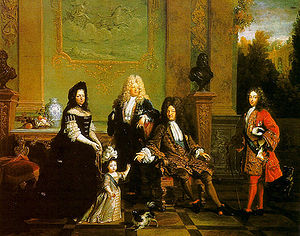 Louis XIV (seated) with his son le Grand Dauphin (to the left), his grandson Louis, Duke of Burgundy (to the right), his great-grandson Louis, Duke of Brittany, and Madame de Ventadour, Brittany's governess, who commissioned this painting; busts of Henry IV and Louis XIII in the background.
Louis XIV (seated) with his son le Grand Dauphin (to the left), his grandson Louis, Duke of Burgundy (to the right), his great-grandson Louis, Duke of Brittany, and Madame de Ventadour, Brittany's governess, who commissioned this painting; busts of Henry IV and Louis XIII in the background.
After a reign of 72 years, Louis died of gangrene at Versailles on 1 September 1715, four days before his 77th birthday.
Reciting the psalm Domine, ad adjuvandum me festina (O Lord, make haste to help me), Louis "yielded up his soul without any effort, like a candle going out".[59] His body lies in Saint-Denis Basilica, outside Paris.
The Dauphin had predeceased Louis in 1711, leaving three children: Louis, Duke of Burgundy; Philip V of Spain; and Charles, Duke of Berry. The eldest, Burgundy, followed in 1712, and was himself soon followed by his elder son, Louis, Duke of Brittany. Thus, on Louis XIV's deathbed, his heir was his five-year-old great-grandson, Louis, Duke of Anjou, Burgundy's youngest son, and Dauphin after the deaths in short succession of his grandfather, father and elder brother.
Louis foresaw a minority and sought to restrict the power of his nephew, Philippe d'Orléans, who as closest surviving legitimate relative in France would become the prospective Louis XV's regent. Accordingly, he created a regency council as Louis XIII did in anticipation of his own minority with some power vested in his illegitimate son, Louis Auguste de Bourbon, duc du Maine.[60]
Orléans, however, would have Louis's will annulled by the Parlement de Paris after his death and make himself sole regent. He stripped Maine and his brother, Louis-Alexandre de Bourbon, comte de Toulouse, of the rank of "prince of the blood", which Louis had given them, and significantly reduced Maine's power and privileges.[61]
Legacy
According to Philippe de Dangeau's Journal, Louis on his deathbed advised his heir:
"Do not follow the bad example which I have set you; I have often undertaken war too lightly and have sustained it for vanity. Do not imitate me, but be a peaceful prince, and may you apply yourself principally to the alleviation of the burdens of your subjects".[62]
Given the Baroque inclination to magnify one's sins as a demonstration of piety, however, some historians argue that Louis may have been too harsh with himself.[62] For instance, despite engaging in many years of war, Louis ultimately placed a French prince successfully on the Spanish throne. This largely ended the threat, dating back to the 16th century, of a hostile Spain that had frequently interfered in domestic French politics. Moreover, Louis's wars expanded France and created a more defensible frontier, protecting his country from foreign invasion at least until the Revolution.
Louis arguably applied himself to "the alleviation of the burdens of [his] subjects". For example, Louis's patronage of the arts encouraged the growth of industry, and his policies increased trade and commerce. Furthermore, his consolidation of royal authority over the feudal elites significantly reduced the incidence of civil wars and aristocratic rebellions, which had frequently plagued France before Louis's reign.[63] His early reforms and centralisation of France also marked the birth of the modern State and served as an example of political organisation for much of Europe during the Enlightenment.
It has been argued that Louis's considerable foreign, military and domestic expenditure impoverished and bankrupted France. Other historians, however, have dismissed such claims.[64] They draw a distinction between the royal treasury, which was impoverished, and France, which was not. In support, they cite the Lettres Persanes by the socio-political thinker and commentator Montesquieu as literary evidence of the wealth and opulence of France and French society even in the darkest days of the royal treasury.
Alternatively, it has been argued that Louis's failure to reform French institutions at a time when monarchy was secure in France led to the social upheaval culminating in the Revolution. In response, other scholars have argued that Louis had little reason to dabble with the reformation of institutions which largely worked well under him. Moreover, he could not reasonably have foreseen and provided for events occurring nearly eighty years after his death, during which time his successors could have successfully instituted reforms but failed to do so.[65]
Ultimately, in often triumphant wars against several great European alliances, Louis gave France ten new provinces, an overseas empire and the pre-eminent position in Europe. His political and military victories, as well as numerous cultural achievements,[66] earned France the admiration of Europe for its success, power and sophistication. Much of Europe began to emulate French manners, values, goods and way-of-life. The European elite even conversed increasingly in predominantly French. Louis himself became the model for many Enlightenment monarchs.
Louis, it seems, had his personal flaws. Saint-Simon, who claimed that Louis slighted him, criticised him thus:
"There was nothing he liked so much as flattery, or, to put it more plainly, adulation; the coarser and clumsier it was, the more he relished it".
However, the anti-Bourbon Napoleon honoured Louis not only as "a great king", but also as "the only King of France worthy of the name".[67] Indeed, even the German Protestant philosopher Leibniz commended him as "one of the greatest kings that ever was".[68] And Lord Acton went so far as to describe Louis as "by far the ablest man who was born in modern times on the steps of a throne".[69] Finally, comparing Louis to Augustus, Voltaire dubbed his reign "an eternally memorable age" and "le Grand Siècle" (the "Great Century").
Image and depiction
Few rulers in world history have commemorated themselves in as grand a manner as Louis.[70] Louis used the arts and court ritual to demonstrate, augment and maintain his control over France. With his support, Colbert established from the beginning of Louis's personal reign a centralised and institutionalised system for creating and perpetuating the royal image. The King was thus portrayed largely in majesty or at war, notably against Spain. This portrayal of the monarch was to be found in numerous media of artistic expression, such as painting, sculpture, theatre, dance, music, and the almanacs which diffused royal propaganda to the population at large.
Evolution of royal portraiture
Over his lifetime, Louis commissioned numerous works of art to portray himself, amongst which are over 300 formal portraits. The earliest portrayals of Louis already followed the pictorial conventions of the day in depicting the child king as the majestically royal incarnation of France. This idealisation of the monarch continued in later works. These avoided depicting any trace of smallpox, which Louis suffered from in 1647. Moreover, by the 1660s, Louis began to be shown as a Roman emperor, Apollo or Alexander, as may be seen in many of Le Brun's works such as sculpture, paintings and the decor in major monuments. The depiction of the King in this manner focussed on the allegorical or the mythological, instead of attempting to produce true likenesses. As Louis aged, so too did his likenesses in portraits. However, the conflict between representing him realistically and representing him in the manner required by royal propaganda continued and was demonstrated in Rigaud's Portrait of Louis XIV of 1701 where a 63 year-old Louis appears to stand on a set of unnaturally young legs.[71]
Indeed, Rigaud's portrait exemplified the height of royal portraiture in Louis's reign. Although Rigaud made a credible likeness of Louis, the portrait was neither meant as an exercise in realism nor to explore Louis's personal character. Rather, it was intended to glorify the monarchy. Rigaud's original, now housed in the Louvre, was originally meant as a gift to Louis's grandson, Philip V of Spain. However, Louis was so pleased with the work that he kept the original and commissioned a copy to be sent to his grandson. That became the first of many copies, both in full and half-length formats, to be made by Rigaud, often with the help of his assistants. The portrait also became a model for French royal and imperial portraiture down to the time of Charles X, over a century later. In his work, Rigaud proclaims Louis's exalted royal status through his elegant stance and haughty expression, the royal regalia and throne, rich ceremonial fleur-de-lys robes, as well as the upright column in the background, which, together with the drapperies, serves to frame this image of majesty. Despite the vast expanse of canvas he had to cover, Rigaud was also concerned with details and depicted in great detail the King's costume, even his shoe buckles.[72]
Other works of art
In addition to these portraits, Louis also commissioned at least twenty statues of himself in the 1680s to stand in Paris and in provincial towns as physical manifestations of himself to his people. He also commissioned "war artists" to follow him on campaign to document his military triumphs. To remind the people of these triumphs, Louis erected in Paris and the provinces permanent triumphal arches for the first time since the decline of the Roman Empire. Louis's reign also marked the birth and infancy of the art of medallions. 16th century rulers had often issued medals to commemorate the major events of their reigns. Louis, however, struck more than 300, celebrating the story of the King in bronze to be enshrined in thousands of households. He also used tapestries as a main medium of exalting the monarchy. Tapestries were either allegorical, depicting the elements or seasons, or realist, portraying royal residences or historical events. They were amongst the most significant means of royal propaganda prior to the construction of the Hall of Mirrors (French: la Galerie des Glaces) at Versailles.[73]
At Versailles
It was at his great palace, with its gardens, architecture, interior design and works of art, that Louis sought to visually represent the absolute power of the monarchy. The Hall of Mirrors became the setting for court events and became the most prestigious part of the vast complex. Under the King's close supervision, Le Brun finalised the decoration of the Hall of Mirrors, which retraced the important accomplishments of Louis's reign, such as his accession or the War of Devolution. Decorative arches emphasise the significant events during the Dutch War. These decorations were intended to depict Louis's grandeur and understandably omit any mention of French losses and defeats suffered as well as the subsequent diplomatic isolation of France.
Ballet
Louis loved ballet and frequently danced in court ballets during the early half of his reign. He danced four parts in three of Molière's comédies-ballets—plays accompanied by music and dance. Louis played an Egyptian in Le Mariage forcé in 1664, a Moorish gentleman in Le Sicilien in 1667, and both Neptune and Apollo in Les Amants magnifiques in 1670. However, performances at court and in Paris differed substantially. Performances at court were often accompanied by suitably majestic music, especially for those ballets danced by the King. Moreover, the lyrics usually conveyed royal power and benevolence as the patron of the arts. On the other hand, parts played by the King no longer stood out from those of other performers when performed in Paris. In fact, the plays which most overtly promoted Louis's royal image were not performed at all outside of court. This testifies to Molière's readiness to adapt his plays according to the venue and the audience.[74]
Unofficial image
Besides the official depiction and image of Louis, his subjects also followed a non-official discourse, consisting mainly of clandestine publications, popular songs, and rumors. This provided an alternative interpretation of the King and his government. They often focussed on the miseries arising from poor government, but also carried the hope for a better future in the event the King escaped the malignant influence of his ministers and mistresses and took the government into his own hands. On the other hand, petitions addressed either directly to Louis or to his ministers exploited the traditional imagery and language of monarchy. These varying interpretations of Louis abounded in self-contradictions that reflected the people's amalgamation of their everyday experiences with the idea of monarchy.[75]
Piety and religion
 Louis XIV encouraged Catholic proselytism through the creation of the Paris Foreign Missions Society.
Louis XIV encouraged Catholic proselytism through the creation of the Paris Foreign Missions Society.
Brought up by his Spanish mother to respect Roman Catholicism, Louis became a largely pious and devout king. Viewing himself as the protector of the Gallican Church, Louis made his devotions daily regardless of where he was, following the liturgical calendar regularly. Towards the middle and the end of his reign, the centre for the King's religious observances was usually the Chapelle Royale at Versailles. Ostentation was a distinguishing feature of daily Mass, annual celebrations, such as those of Holy Week, and special ceremonies.[76] Louis's concern for the spread of the Gospel led him to establish the Paris Foreign Missions Society. Nevertheless, his informal alliance with the Ottoman Empire was criticised for being un-Christian because it supported an Islamic power against much of Christendom.[77]
Quotes
The phrase "L'Etat, c'est moi" ("The state, it is I") is frequently attributed to him, though considered an inaccuracy by historians.[78]
Quite contrary to that apocryphal quote, Louis XIV is actually reported to have said on his death bed: "Je m'en vais, mais l'État demeurera toujours." ("I depart, but the State shall always remain").[79]
Style and arms
Louis's formal style was "Louis XIV, par la grâce de Dieu, roi de France et de Navarre", or "Louis XIV, by the Grace of God, King of France and of Navarre". His arms were Azure three fleurs-de-lis Or (for France) impaling Gules on a chain in cross saltire and orle Or an emerald Proper (for Navarre).
Order of Saint Louis
On 5 April 1693, Louis also founded the Royal and Military Order of Saint Louis (French: Ordre Royal et Militaire de Saint-Louis), a military Order of Chivalry.[80][81] He named it after Louis IX and intended it as a reward for outstanding officers. It is notable as the first decoration that could be granted to non-nobles and is roughly the forerunner of the Légion d'honneur, with which it shares the red ribbon (though the Légion d'honneur is awarded to military personnel and civilians alike).
See also
- List of French monarchs
- France
- Outline of France
- Levée (ceremony)
- Charles de Lorme, personal medical doctor to Louis XIV
Ancestors
Ancestors of Louis XIV of FranceIssue
Legitimate Children of Louis XIV of FranceIllegitimate Children of Louis XIV of FranceIn fiction
Alexandre Dumas portrayed Louis in novels, first as a child in Twenty Years After, then as a young man in The Vicomte de Bragelonne, in which he is a central character. French academic Jean-Yves Tadié argued that the latter novel really revolves around the beginning of Louis's personal rule.[82] Dumas's novel The Man in the Iron Mask recounts the legend that the mysterious prisoner was actually Louis's twin brother and has spawned numerous film adaptations.
In 1910, the American historical novelist Charles Major wrote "The Little King: A Story of the Childhood of King Louis XIV". Louis is a major character in the 1959 historical novel "Angélique et le Roy" ("Angélique and the King"), part of the Angelique Series. The protagonist, a strong-willed lady at Versailles, rejects the King's advances and refuses to become his mistress. A later book, the 1961 "Angélique se révolte" ("Angélique in Revolt") details the dire consequences of her defying this powerful monarch.
A character based on Louis plays an important role in The Age of Unreason, a series of four alternate history novels written by American science fiction and fantasy author Gregory Keyes.
While The Taking of Power by Louis XIV, directed by Roberto Rossellini in 1966, shows Louis's rise to power after the death of Cardinal Mazarin, Le Roi Danse (The King Dances), directed by Gérard Corbiau in 2000, reveals Louis through the eyes of Jean-Baptiste Lully, his court musician. Julian Sands portrayed Louis in Roland Jaffe's Vatel in 2000.
Louis features significantly in Neal Stephenson's Baroque Cycle, specifically The Confusion, the greater part of which takes place at Versailles.
In the 39 Clues series universe, it has been noted that Louis was part of the Cahill branch, Tomas.
The 16-year-old Louis XIV, as played by the Irish actor Robert Sheehan, was a major character of the short-lived historical fantasy series Young Blades from January to June 2005.
Notes
- ^ See List of Navarrese monarchs and their family tree.
- ^ "Louis XIV". MSN Encarta. 2008. Archived from the original on 1 November 2009. http://www.webcitation.org/query?id=1257052204396412. Retrieved 20 January 2008.
- ^ a b c "Louis XIV". Catholic Encyclopedia. 2007. http://www.newadvent.org/cathen/09371a.htm. Retrieved 19 January 2008.
- ^ (French)Brémond, Henri La Provence mystique au XVIIe siècle. Paris: Plon-Nourrit, 1908. pp. 381, 382.
- ^ François Bluche (translated by Mark Greengrass (1990). Louis XIV. New York: Franklin Watts. p. 11. ISBN 0531151123.
- ^ Ian Dunlop, "Louis XIV", (2001) p. xii
- ^ Merryman, John Henry. "The Civil Law Tradition: An Introduction to the Legal Systems of Europe and Latin America", 2007 Stanford University Press.
- ^ Antoine, Michel, Louis XV, Fayard, Paris, 1989, p. 33
- ^ a b Louis de Rouvroy, duc de Saint-Simon. "Historical Memoirs of the Duc de Saint-Simon, volume 1 1691–1709: The Court of Louis XIV". http://www.fordham.edu/halsall/mod/17stsimon.html. Retrieved 19 January 2008.
- ^ Dunlop, Ian. "Louis XIV", p. 242-251, Pimlico London 2001.
- ^ Dunlop, p. 247.
- ^ Bluche, François. "Louis XIV", p. 497, Hachette Litteratures, Paris (1986).
- ^ Dunlop, p. 54.
- ^ Lynn, John A. (1999). The Wars of Louis XIV (1667–1714). Longman New York. p.161-171.
- ^ Faroqhi, p.73 The Ottoman Empire and the World Around it
- ^ Bluche, p. 439.
- ^ Keay, John. "The Honourable Company: A History of the English East India Company", p. 201-204, Harper Collins Publishers, London (1993).
- ^ Pagani, Catherine, Eastern Magnificence and European Ingenuity: Clocks of Late Imperial China, p.182, (2001) [1]
- ^ Sullivan, Michael, The Meeting of Eastern and Western Art Page 98, (1989) ISBN 0520212363 [2]
- ^ Barnes, Linda L. (2005) Needles, Herbs, Gods, and Ghosts: China, Healing, and the West to 1848 Harvard University Press ISBN 0674018729, p.85
- ^ Mungello, David E. (2005) The Great Encounter of China and the West, 1500–1800 Rowman & Littlefield ISBN 074253815X, p.125
- ^ Coincidentally, at roughly the same time and for the same reasons, Japan adopted a similar policy, called sankin kōtai.
- ^ Meriman, John (1996). A History of Modern Europe. W.W. Norton & Company. p. 319.
- ^ Buckley, Veronica. Madame de Maintenon: The Secret Wife of Louis XIV. London: Bloomsbury, 2008
- ^ "Morganatic and Secret Marriages in the French Royal Family". http://www.heraldica.org/topics/france/morganat.htm. Retrieved 10 July 2008.: The description of the marriage as morganatic is inaccurate as French law does not define such marriages.
- ^ For example, see Buckley, Veronica. Madame de Maintenon: The Secret Wife of Louis XIV. London: Bloomsbury, 2008
- ^ Sturdy, David J. "Louis XIV", St Martin's Press, New York (1998), p. 89-99.
- ^ Sturdy, p. 92-93.
- ^ Sturdy, p. 96, citing Pillorget, "France Baroque, France Classique", i, 935.
- ^ Sturdy, p. 96-97.
- ^ Bluche, p. 20-21.
- ^ Cathal J. Nolan, Wars of the age of Louis XIV, 1650–1715 (2008) p. 132
- ^ Columbia Encyclopedia (2007). "Louis XIV, king of France". http://www.bartleby.com/65/lo/Louis14Fr.html. Retrieved 19 January 2008.
- ^ David J. Sturdy, p. 98, citing W.C. Scoville, The Persection of Huguenots and French Economic Development, 1680–1720 (1960)
- ^ Durant, Will and Ariel. "The Story of Civilisation (Volume 8): The Age of Louis XIV", Simon & Schuster, New York (1963), p. 691.
- ^ Lynn, John A. (1999). "The Wars of Louis XIV (1667–1714)". Longman New York, p.192.
- ^ Dunlop, Ian. "Louis XIV", p. 313, Pimlico London 2001.
- ^ Lynn, John A., p.189-191.
- ^ Lynn, John A., p.192-193.
- ^ a b Lynn, John A.
- ^ Lynn, John A., p. 232.
- ^ Lynn, John A., p. 253.
- ^ Bluche, p. 653.
- ^ Lossky, Andrew. "Louis XIV and the French Monarchy", New Brunswick, New Jersey (1994), p. 255
- ^ Lynn, John A., p. 256.
- ^ Lynn, John A., p.267.
- ^ a b Dunlop, Ian. "Louis XIV", p. 353, Pimlico London 2001.
- ^ a b Lynn, p.268.
- ^ Kamen, Henry. (2001) Philip V of Spain: The King who Reigned Twice, Yale University Press, p. 6. ISBN 0300087187.
- ^ Dunlop, p. 358.
- ^ Lynn, p.269, see footnote 1.
- ^ Lynn, p.269-270.
- ^ Merriman, page 321.
- ^ Ó Gráda, Cormac; Chevet, Jean-Michel (2002). "Famine And Market In Ancient Régime France". The Journal of Economic History 62 (3): 706–733. doi:10.1017/S0022050702001055. PMID 17494233. [3]
- ^ Lynn, p. 326.
- ^ Lynn, p. 334.
- ^ Lynn, p. 342.
- ^ Lynn, p. 356-360.
- ^ Dunlop, p. 468.
- ^ Dunlop, p. 454-455.
- ^ Antoine, p. 33-37.
- ^ a b Bluche, p. 890.
- ^ See above, section on "Height of Power".
- ^ Bluche, p. 876, Hachette Litteratures, Paris (1986).
- ^ Bluche, p. 506 & 877–878, Hachette Litteratures, Paris (1986).
- ^ Dunlop, p. 433; citing Montesquieu: "Louis established the greatness of France by building Versailles and Marly".
- ^ Napoleon Bonaparte, Napoleon's Notes on English History made on the Eve of the French Revolution, illustrated from Contemporary Historians and referenced from the findings of Later Research by Henry Foljambe Hall. New York: E. P. Dutton & Co., 1905, 258.
- ^ Bluche, p. 926.
- ^ Durant, Will and Ariel. "The Story of Civilisation (Volume 8): The Age of Louis XIV", p. 721.
- ^ Burke, Peter (1992). "The fabrication of Louis XIV". History Today 42 (2)
- ^ Perez, Stanis (2003). "Les Rides D'apollon: L'evolution Des Portraits de Louis XIV [Apollo's Wrinkles: the Evolution of Portraits of Louis XIV]". Revue D'histoire Moderne et Contemporaine 50 (3): 62–95. ISSN 0048-8003
- ^ See also Schmitter, Amy M. (2002). "Representation and the Body of Power in French Academic Painting". Journal of the History of Ideas 63 (3): 399–424. doi:10.1353/jhi.2002.0027. ISSN 0022-5037. JSTOR 3654315
- ^ Sabatier, Gérard (2000). "La Gloire du Roi: Iconographie de Louis XIV de 1661 a 1672". Histoire, Economie et Société 19 (4): 527–560. doi:10.3406/hes.2000.2134.
- ^ Prest, Julia (2001). "Dancing King: Louis XIV's Roles in Molière's Comedies-ballets, from Court to Town". Seventeenth Century 16 (2): 283–298. ISSN 0268-117x. Fulltext: Ebsco
- ^ Jens Ivo, Engels (2003). "Denigrer, Esperer, Assumer La Realite. Le Roi de France perçu par ses Sujets, 1680–1750" ["Disparaging, Hoping, Taking on Reality: the French King as Perceived by His Subjects, 1680–1750"]". Revue D'histoire Moderne et Contemporaine 50 (3): 96–126.
- ^ Gaudelus, Sébastien (2000). "La Mise en Spectacle De La Religion Royale: Recherches sur la Devotion de Louis XIV". Histoire, Economie et Société 19 (4): 513–526. doi:10.3406/hes.2000.2133.
- ^ The history of England from the accession of James II p. 303 Thomas Babington Macaulay Macaulay, Longman, Green, Longman, Roberts, & Green, 1864.
- ^ Charles Bremner, Times Blogs. "Things French kings never said". http://timescorrespondents.typepad.com/charles_bremner/2009/11/things-french-kings-never-said.html. Retrieved 29 November 2009.[dead link]
- ^ (French) Marquis de Dangeau. "Mémoire sur la mort de Louis XIV (on page 24)". http://gallica.bnf.fr/ark:/12148/bpt6k55404p.image.r=M%C3%A9moire+sur+la+mort+de+Louis+XIV.f27.langFR. Retrieved 29 November 2009.
- ^ Hamilton, Walter. "Dated Book-plates (Ex Libris) with a Treatise on Their Origin", P37. Published 1895. A.C. Black
- ^ Edmunds, Martha. "Piety and Politics", P274. 2002. University of Delaware Press. ISBN 0874136938
- ^ J-Y Tadié's annotations to The Vicomte de Bragelonne, Gallimard, 1997
Further reading
- Ashley, Maurice P. Louis XIV And The Greatness Of France (1965) excerpt and text search
- Beik, William. Louis XIV and Absolutism: A Brief Study with Documents (2000) excerpt and text search
- Beik, William. "The Absolutism of Louis XIV as Social Collaboration." Past & Present 2005 (188): 195–224. online at Project MUSE
- Bluche, François, Louis XIV, (Franklin Watts, 1990)
- Buckley, Veronica. Madame de Maintenon: The Secret Wife of Louis XIV. London: Bloomsbury, 2008
- Burke, Peter. The Fabrication of Louis XIV (1994) excerpt and text search
- Cambridge Modern History: Vol. 5 The Age Of Louis XIV (1908), old, solid articles by scholars; complete text online
- Campbell, Peter Robert. Louis XIV, 1661–1715 (London, 1993)
- Church, William F., ed. The Greatness of Louis XIV. (1972).
- Cowart, Georgia J. The Triumph of Pleasure: Louis XIV and the Politics of Spectacle (U of Chicago Press, 2008) 299 pp; focus on opera and ballet
- Cronin, Vincent. Louis XIV. London: HarperCollins, 1996 (ISBN 0002720728)
- Dunlop, Ian. Louis XIV (2000), 512pp excerpt and text search
- Erlanger, Philippe, Louis XIV (Praeger 1970)
- Fraser, Antonia. Love and Louis XIV: The Women in the Life of the Sun King. London: Weidenfeld & Nicolson, 2006 (hardcover, ISBN 0-297-82997-1); New York: Nan A. Talese, 2006 (hardcover, ISBN 0385509847)
- Goubert, Pierre. Louis XIV and Twenty Million Frenchmen (1972), social history from Annales School
- Jones, Colin. The Great Nation: France from Louis XIV to Napoleon (1715–1799) (2002)
- Lewis, W. H. The Splendid Century: Life in the France of Louis XIV (1953) excerpt and text search; also online complete edition
- Le Roy Ladurie, Emmanuel. The Ancien Regime: A History of France 1610–1774 (1999), survey by leader of the Annales School excerpt and text search
- Lynn, John A. The Wars of Louis XIV, 1667–1714 (1999) excerpt and text search
- Mitford, Nancy. The Sun King (1995), popular excerpt and text search
- Nolan, Cathal J. Wars of the Age of Louis XIV, 1650–1715: An Encyclopedia of Global Warfare and Civilization . (2008) 607pp; over 1000 entries; ISBN 978-0-313-33046-9
- Rowlands, Guy. The Dynastic State and the Army under Louis XIV: Royal Service and Private Interest, 1661–1701 (2002) online edition
- Rubin, David Lee, ed. Sun King: The Ascendancy of French Culture during the Reign of Louis XIV. Washington: Folger Books and Cranbury: Associated University Presses, 1992.
- Shennan, J. H. Louis XIV (1993) online edition
- Thompson, Ian. The Sun King's Garden: Louis XIV, André Le Nôtre And the Creation of the Gardens of Versailles. London: Bloomsbury Publishing, 2006 ISBN 1582346313
- Treasure, Geoffrey. Louis XIV (London, 2001).
- Wilkinson, Rich. Louis XIV (2007)
- Wolf, John B. Louis XIV (1968), the standard scholarly biography online edition
External links
- "Louis XIV."
- "Music and politics in the court of Louis XIV"
- Chronology Louis XIV[dead link]
- Full text of marriage contract (PDF), France National Archives transcription (French)
- "Le siècle de Louis XIV" by Voltaire, 1751
- List of films dedicated to Louis XIV and period ("Louis XIV – the Sun King: Louis XIV – the Sun King". Louis-xiv.de. http://www.louis-xiv.de/index.php?t=films&a=films. Retrieved 31 August 2008.) Of particular interest: Documentary on Versailles—The Visit.
- The Story of Civilization VIII: The Age of Louis XIV online ebook by historians Will Durant and Ariel Durant.
- Louis XIV
- http://genealogics.org/getperson.php?personID=I00000061&tree=LEO
Louis XIV of FranceBorn: 5 September 1638 Died: 1 September 1715Regnal titles Preceded by
Louis XIIIKing of France and Navarre
14 May 1643 – 1 September 1715Succeeded by
Louis XVFrench royalty Preceded by
Louis XIIIDauphin of France
5 September 1638 – 14 May 1643Succeeded by
Louis
"le Grand Dauphin"Preceded by
Gaston, Duke of OrléansHeir to the Throne
as Heir apparent
5 September 1638 – 14 May 1643Succeeded by
Philippe, Duke of OrléansDauphins of France House of Bourbon Louis XIII · Louis XIV · Louis, Le Grand Dauphin · Louis, Le Petit Dauphin · Louis · Louis XV · Louis · Louis Auguste · Louis Joseph · Louis Charles · Louis Antoine
Princes of France The first generation are the children of Henri IV; these males held the rank of Son of France or Grand son of France;1st Generation 
2nd Generation 3rd Generation Louis, Dauphin of France · Philippe Charles, Duke of Anjou* · Louis François, Duke of Anjou* · Philippe Charles, Duke of Valois* · Alexandre Louis, Duke of Valois* · Philippe, Duke of Orléans4th Generation 5th Generation 6th Generation Louis, Dauphin of France · Philippe, Duke of Anjou*7th Generation 8th Generation Louis Joseph, Dauphin of France* · Louis XVII* · Louis Antoine, Duke of Angoulême* · Charles Ferdinand, Duke of Berry*died without surviving issueHouse of Bourbon Henry IV of France Spouse(s)ChildrenSiblingsHenri, Duke of Beaumont (1551–1553) · Louis, Count of Marle (1555–1557) · Madeleine (1556) · Catherine, Duchess of LorraineIllegitimate childrenCésar, Duke of Vendôme · Catherine Henriette, Duchess of Elbeuf · Alexandre, Chevalier de Vendôme · Henri, Duke of Verneuil · Gabrielle Angelique, Duchess of La Valette and Epernon · Antoine, Count of Moret · Jeanne Baptiste, Abess of Fontevraud · Marie Henriette, Abess of ChellesGrandchildrenAnne Marie Louise, Duchess of Montpensier · Marguerite Louise, Grand Duchess of Tuscany · Élisabeth Marguerite, Duchess of Alençon and Angoulême · Françoise Madeleine, Duchess of Savoy · Princess Marie Anne · Jean Gaston, Duke of Valois · Louis XIV of France · Philippe, Duke of OrléansLouis XIII of France Spouse(s)ChildrenLouis XIV of France · Philippe, Duke of OrléansGrandchildrenLouis, Dauphin of France · Princess Anne Élisabeth · Princess Marie Anne · Princess Marie Therèse, Madame Royale · Philippe Charles, Duke of Anjou · Louis François, Duke of Anjou · Marie Louise, Queen of Spain · Philippe Charles, Duke of Valois · Anne Marie, Queen of Sardinia · Alexandre Louis, Duke of Valois · Philippe Charles, Duke of Orléans · Élisabeth Charlotte, Duchess of LorraineGreat
grandchildrenLouis XIV of France Spouse(s)ChildrenLouis, Dauphin of France · Princess Anne Élisabeth · Princess Marie Anne · Princess Marie Therèse, Madame Royale · Philippe Charles, Duke of Anjou · Louis François, Duke of AnjouIllegitimate childrenMarie Anne, Princess of Conti · Louis, Count of Vermandois · Louis Auguste, Duke of Maine · Louis César, Count of Vexin · Louise Françoise, Duchess of Bourbon · Louise Marie Anne, Mademoiselle de Tours · Françoise Marie, Duchess of Orléans · Louis Alexandre, Count of Toulouse · Louise, Baroness of La QueueGrandchildrenLouis, Duke of Burgundy · King Felipe of Spain+ · Charles, Duke of Berry · Louis Auguste, Prince of Dombes · Louis Charles, Count of Eu · Louise Françoise, Mademoiselle du Maine · Louis Jean Marie, Duke of PenthièvreGreat
grandchildrenLouis, Duke of Brittany · Louis, Duke of Brittany · Louis XV of France · Louis I of Spain* · Felipe of Spain* · Felipe of Spain* · Ferdinand VI of Spain* · Charles III of Spain* · Francisco of Spain* · Mariana Víctoria, Queen of Portugal* · Philip, Duke of Parma* · Maria Teresa Rafaela, Dauphine of France* · Luis, Count of Chinchón* · Maria Antonietta, Queen of Sardinia* · Charles, Duke of Alençon · Marie Louise Élisabeth d'Alençon · Louis Alexandre, Prince of LamballeLouis XV of France Spouse(s)ChildrenLouise Élisabeth, Duchess of Parma · Princess Henriette · Princess Louise · Louis, Dauphin of France · Philippe, Duke of Anjou · Marie Adélaïde, Duchess of Louvois · Princess Victoire · Sophie, Duchess of Louvois · Princess Thérèse · Princess Louise MarieGrandchildrenPrincess Marie Therèse, Madame Royale · Princess Marie Zéphyrine · Louis, Duke of Burgundy · Xavier, Duke of Aquitaine · Louis XVI of France · Louis XVIII of France · Charles X of France · Clothilde, Queen of Sardinia · Princess ÉlisabethIllegitimate children
includedCharles de Vintimille · Agathe Louise de Saint-Antoine · Philippe, Duke of Narbonne-Lara · Louis, Count of Narbonne-LaraLouis XVI of France Spouse(s)ChildrenMarie Thérèse, Duchess of Angoulême · Louis Joseph, Dauphin of France · Louis XVII of France · Princess Sophie HélèneLouis XVII of France NoteLouis had no children; he died aged 10 in 1795. His uncle, the future Louis XVIII of France, proclaimed himself regent but both titles were disputed.
See Bourbon Restoration.Louis XVIII of France Spouse(s)Charles X of France Spouse(s)ChildrenLouis Antoine, Duke of Angoulême · Sophie, Mademoiselle · Charles Ferdinand, Duke of Berry · Marie Thérèse, Mademoiselle d'AngoulêmeGrandchildrenPrincess Louise Élisabeth · Prince Louis · Louise Marie Thérèse, Duchess of Parma · Henry, Count of ChambordNotes: *also an Infante or Infanta of Spain · **also an Archduchess of Austria · ***both · +Philip was the first Bourbon king of Spain, the country's present ruling house
List of French monarchs Merovingians
(481–751)Clovis Ist (481–511) • Chlothar I (511–561) • Charibert I (561–567) • Guntram (561–593) • Chilperic I (561–584) • Sigebert I (561–575) • Chlothar II (584–629) • Dagobert I (629–639) • Sigebert II (639–656) • Clovis II (639–657) • Chlothar III (657–673) • Theuderic III (673–691) • Clovis III (691–695) • Childebert III (695–711) • Dagobert III (711–715) • Chilperic II (715–721) • Chlothar IV (717–719) • Thierry IV (721–737) • Childeric III (737–751)Carolingians
(843–888, 898–922, 936–987)Pepin III (751–768) • Carloman I (768–771) • Charlemagne (768–814) • Louis I (814–840) • Charles I (843–877) • Louis II (877–879) • Louis III (879–882) • Carloman II (879–884) • Charles II (885–888) • Charles III (898–922) • Louis IV (936–954) • Lothair IV (954–986) • Louis V (986–987)Robertians
(888–898, 922–923)Eudes of Paris (888–898) • Robert I (922–923)Bosonids
(923–936)House of Capet
(987–1328)Hugh (987–996) • Robert II (996–1031) • Henry I (1031–1060) • Philip I (1060–1108) • Louis VI (1108–1137) • Louis VII (1137–1180) • Philip II (1180–1223) • Louis VIII (1223–1226) • Louis IX (1226–1270) • Philip III (1270–1285) • Philip IV (1285–1314) • Louis X (1314–1316) • John I (1316) • Philip V (1316–1322) • Charles IV (1322–1328)House of Valois
(1328–1498)Philip VI (1328–1350) • John II (1350–1364) • Charles V (1364–1380) • Charles VI (1380–1422) • Charles VII (1422–1461) • Louis XI (1461–1483) • Charles VIII (1483–1498)House of Valois-Orléans
(1498–1515)House of Valois-Angoulême
(1515–1589)Francis I (1515–1547) • Henry II (1547–1559) • Francis II (1559–1560) • Charles IX (1560–1574) • Henry III (1574–1589)House of Bourbon
(1589–1792)Henry IV (1589–1610) • Louis XIII (1610–1643) • Louis XIV (1643–1715) • Louis XV (1715–1774) • Louis XVI (1774–1792) • Louis XVII (claimant, 1792–1795)House of Bonaparte
First Empire (1804–1814, 1815)Napoleon I (1804–1814, 1815) • Napoleon II (1815)House of Bourbon
Bourbon Restoration
(1814, 1815–1830)House of Orléans
July Monarchy (1830–1848)Louis Philippe I (1830–1848)House of Bonaparte
Second Empire (1852–1870)Categories:- 1638 births
- 1715 deaths
- Burials at the Basilica of St Denis
- People from Saint-Germain-en-Laye
- Louis XIV of France
- House of Bourbon (France)
- Kings of France
- Dauphins of Viennois
- Dauphins of France
- Roman Catholic monarchs
- Anti-Protestantism
- Princes of France (Bourbon)
- Princes of Andorra
- Modern child rulers
- French military personnel of the Nine Years' War
- Recipients of the Order of the Holy Spirit
- 18th-century French people
- 17th-century French people
- People of the Regency of Philippe d'Orléans
- People of the Ancien Régime
- Deaths from gangrene
Wikimedia Foundation. 2010.

